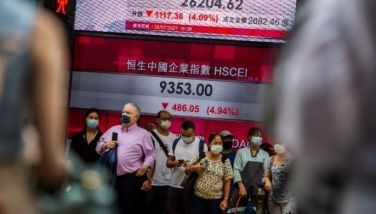Net portfolio investment triples to $202-M last year
January 15, 2003 | 12:00am
Speculations on the future borrowing of the Arroyo administration attracted a steady stream of foreign hot money into the fixed income securities market last year, pushing portfolio investments up almost three times for the whole year.
Data from the Bangko Sentral ng Pilipinas (BSP) revealed that net portfolio investments increased from $68.7 million in 2001 to $202 million for the whole of 2002.
According to the BSP, a total of $1.27 billion in portfolio funds actually entered the country but $1.07 billion exited almost immediately and left only $202 million for the whole year.
"These funds are being invested into the money market and in government securities," BSP Governor Rafael B. Buenaventura said, adding that the funds were lured into the country by the broad decline in US interest rates which compelled investors to look for other places to make a quick profit.
The US Federal Reserve’s benchmark rate is now at a 40-year low of 1.25 percent compared to the Philippines’ comparative overnight rate of seven percent, providing a generous spread for investors. Portfolio investments are liquid assets that normally go into stocks, bonds or money markets. These funds do not stay long and give little contribution to the local economy but their behavior is often used as a barometer for investor sentiment and perception of the market.
Hot money inflows also have an impact on the prices of securities and other assets like property.
Foreign portfolio investments in 2001 were even more fickle.
The BSP reported that $1.23-billion worth of inflows came in but left only $68 million as $1.16-billion flowed right out of the country.
Despite the unpredictability of hot money inflows, Buenaventura opted to be optimistic. "While broadly the same amounts are coming into the local financial system, more and more funds are staying onshore for longer periods," Buenaventura said.
According to him, investors were warming up to the Philippines despite its economic and political problems.
Much of the portfolio investments that entered the country in 2002 went into fixed-income instruments such as bonds.
The BSP’s portfolio investment data is based on reports from the country’s top five securities custodian banks, namely Hongkong Shanghai Banking Corp., Standard Chartered Bank, Citibank N.A., Deutsche Bank, and ING Bank.
Together, the five account for over 95 percent of total portfolio volume in the Philippines.
Data from the Bangko Sentral ng Pilipinas (BSP) revealed that net portfolio investments increased from $68.7 million in 2001 to $202 million for the whole of 2002.
According to the BSP, a total of $1.27 billion in portfolio funds actually entered the country but $1.07 billion exited almost immediately and left only $202 million for the whole year.
"These funds are being invested into the money market and in government securities," BSP Governor Rafael B. Buenaventura said, adding that the funds were lured into the country by the broad decline in US interest rates which compelled investors to look for other places to make a quick profit.
The US Federal Reserve’s benchmark rate is now at a 40-year low of 1.25 percent compared to the Philippines’ comparative overnight rate of seven percent, providing a generous spread for investors. Portfolio investments are liquid assets that normally go into stocks, bonds or money markets. These funds do not stay long and give little contribution to the local economy but their behavior is often used as a barometer for investor sentiment and perception of the market.
Hot money inflows also have an impact on the prices of securities and other assets like property.
Foreign portfolio investments in 2001 were even more fickle.
The BSP reported that $1.23-billion worth of inflows came in but left only $68 million as $1.16-billion flowed right out of the country.
Despite the unpredictability of hot money inflows, Buenaventura opted to be optimistic. "While broadly the same amounts are coming into the local financial system, more and more funds are staying onshore for longer periods," Buenaventura said.
According to him, investors were warming up to the Philippines despite its economic and political problems.
Much of the portfolio investments that entered the country in 2002 went into fixed-income instruments such as bonds.
The BSP’s portfolio investment data is based on reports from the country’s top five securities custodian banks, namely Hongkong Shanghai Banking Corp., Standard Chartered Bank, Citibank N.A., Deutsche Bank, and ING Bank.
Together, the five account for over 95 percent of total portfolio volume in the Philippines.
BrandSpace Articles
<
>
- Latest
- Trending
Trending
Latest
Trending
Latest
Recommended

























